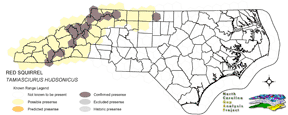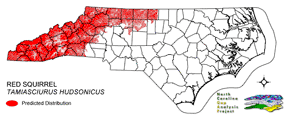
| Taxa: |
| Order: |
| Family: |
| Mammalia |
| Rodentia |
| Sciuridae |
| NatureServe Global Rank: |
| NatureServe State (NC) Rank: |
| G5 |
| S5 |
| Federal Status: |
| NC State Status: |
| --- |
| --- |


| Land Unit |
| US Fish & Wildlife Service |
| US Forest Service |
| US National Park Service |
| US Department of Defense |
| NC State Parks |
| NC University System |
| NC Wildlife Res. Com. |
| NC Forest Service |
| NC Div. of Coastal Mgmt. |
| Local Governments |
| Non-Governmental Org. |
| Other Public Lands |
| Private Lands |
| GAP Status 1-2 |
| All Protected Lands |
| Statewide |
| Hectares |
| 70.29 |
| 395,005.50 |
| 478.26 |
| 124,021.44 |
| 18,384.48 |
| 340.11 |
| 23,430.06 |
| 3,214.35 |
| 0.00 |
| 7,432.20 |
| 7,056.99 |
| 54.09 |
| 1,904,656.77 |
| 202,593.33 |
| 578,790.63 |
| 2,484,144.54 |
| Acres |
| 173.69 |
| 976,079.66 |
| 1,181.81 |
| 306,463.59 |
| 45,429.03 |
| 840.43 |
| 57,896.93 |
| 11,181.79 |
| 0.00 |
| 18,365.36 |
| 17,438.20 |
| 133.66 |
| 4,706,508.46 |
| 503,857.88 |
| 1,433,461.47 |
| 6,141,692.60 |
| % of Dist. on |
| Prot. Lands |
| < 0.1 % |
| 68.2 % |
| < 0.1 % |
| 21.4 % |
| 3.2 % |
| < 0.1 % |
| 4.0 % |
| 0.6 % |
| 0.0 % |
| 1.1 % |
| 1.1 % |
| < 0.1 % |
| 0.0 % |
| 35.0 % |
| ----- |
| ----- |
| % of Dist. on |
| All Lands |
| < 0.1 % |
| 15.9 % |
| < 0.1 % |
| 5.0 % |
| 0.7 % |
| < 0.1 % |
| 0.9 % |
| 0.1 % |
| 0.0 % |
| 0.3 % |
| 0.3 % |
| < 0.1 % |
| 76.7 % |
| 8.2 % |
| ----- |
| ----- |
|
Primarily associated with high and mid-elevation coniferous forests in the southern Appalachian mountains, but will also inhabit hardwood forests at those elevations (Whitaker and Hamilton 1998). They have been noted as being particularly abundant where there are spruce and hemlock trees (Linzey and Linzey 1971; Webster et al. 1985). However, forest type
may not be as important to the squirrel as the availability of food and shelter. Red squirrels are very adaptable in establishing their shelters. They use abandoned woodpecker cavities, holes in the ground or crevices in rocky places, or will build a nest of available materials (sticks, leaves or bark, or some combination thereof) in the crotch or branch of a tree (Hamilton 1964). Old nests of crows and hawks are also used. NATURE SERVE GLOBAL HABITAT COMMENTS: Prefers coniferous and mixed forests, but also frequently occurs in deciduous woodlots, hedgerows, second-growth areas. Prefers to nest in tree cavities; also constructs leaf nests and uses ground burrows. |
| Code | Name | Description | NC Natural Heritage Program Equivalent |
| 230 | Piedmont Mesic Forest | American Beech - Red Oak - White Oak Forests. | Mesic Mixed Hardwood |
| 384 | Piedmont/Mountain Mixed Bottomland Hardwood Forests | Includes temporarily to seasonally forests dominated by hardwood species. Hardwoods include sweetgum, red maple, sycamore which co-occur in a mosaic of bottomland and levee positions. Includes alluvial hardwood forests in the mountains. Hemlock and white pine may occur as inclusions, but are generally mapped separately. | Piedmont/Mountain Alluvial Forest, Piedmont/Mountain Levee Forest |
| 383 | Piedmont Mixed Successional Forest | Generally loblolly mixed with successional hardwoods. Sweetgum, tulip poplar and red maple are common co-dominants in these successional forests. | No equivalent |
| 228 | Piedmont Dry-Mesic Oak and Hardwood Forests | Primarily oak dominated forests, white oak is often dominant, with co-dominants including . Also represented by sweetgum and tulip poplar dominated forests. | Dry Mesic Oak Hickory Forest, Basic Oak Hickory Forest, Dry Oak Hickory Forest |
| 222 | Piedmont Dry-Mesic Pine Forests | Loblolly dominated forests resulting from succession following clearing. This type occurs on all moisture regimes following disturbance with the exception of the extremely xeric sites. | No equivalent |
| 382 | Dry Mesic Oak Pine Forests | Mixed forests of the coastal plain and piedmont. Includes loblolly pine with white, southern red and/or post oak and loblolly with water oak. On basic sites of the piedmont, eastern red cedar may co-occur with post, black, and blackjack oaks. | Dry Mesic Oak Hickory Forest, Xeric Hard Pan Forest, Chestnut Oak Forest, Dry Mesic Oak Hickory Forest, Dry Oak Hickory Forest |
| 220 | Piedmont Xeric Pine Forests | Dry to xeric pine forests dominated by Virginia pine, shortleaf pine or Eastern Red Cedar. | Pine Oak Heath |
| 226 | Piedmont Xeric Woodlands | Generally post and blackjack oak dominated woodlands. White ash and pignut hickory can be found in combination with Eastern red cedar on glades. | Xeric Hardpan Forest |
| 21 | Coniferous Cultivated Plantation (natural / planted) | Managed pine plantations, densely planted. Most planted stands are loblolly, but slash and longleaf occur as well. | No equivalent |
| 51 | Deciduous Cultivated Plantation | Planted deciduous trees. Includes sweetgum and sycamore plantations. | No equivalent |
| 517 | Hemlock Floodplain Forest | Alluvial forest with hemlock and/or white pine in mountains and western piedmont. Hydrology is generally temporarily to seasonally flooded. | Canada Hemlock Forest |
| 521 | Spruce/Fir Forest | High Elevation Frazer-Fir - Red Spruce, Red Spruce and Red-Spruce-Yellow Birch Forests. Tree densities included here include both woodland to forest density. Highly intermixed with Northern Hardwoods, Grassy Balds, and Shrub Balds. | Red Spruce--Fraser Fir Forest, Fraser Fir Forest |
| 522 | Northern Hardwoods | High Elevation forests including yellow birch, American beech, and yellow buckeye. Includes forests with Hemlock and Yellow Birch. | Northern Hardwoods Forest, Boulderfield Forest |
| 525 | Appalachian Oak Forest | A variety of oak forest types including Black, White, Scarlet Oaks in dry to mesic situations. Includes forests historically co-dominated by American Chestnut. | High Elevation Red Oak Forest, Montane White Oak Forest |
| 526 | Appalachian Cove Forest | Mixed Mesophytic forests of the mountains. Includes tuliptree, basswood, yellow buckeye and surgar maple. This class is mapped to include cove forests dominated or co-dominated by hemlock. | Rich Cove Forest, Acidic Cove Forest |
| 527 | Appalachian Hemlock | Upland hemlock forests of the moutains region. Vary from side slopes to steep slope positions. | Canada Hemlock Forest |
| 528 | Appalachian Xeric Pine Forest | Pine forests and woodlands on xeric sites. A variety of pines, including Virginia, Shortleaf, Eastern White Pine, Table Mountain and Pitch pine. Often small areas of dense pine within a matrix of Xeric Oak-Pine Forests. | Pine Oak Heath |
| 529 | Appalachian Xeric Mixed Forest | Mixed forests with Virginia, Shortleaf, Eastern White Pine, Table Mountain and Pitch pines in combination with xeric oak species. Oaks include, white, Southern Red, black, and rock chestnut. | Pine Oak Heath |
| 530 | Appalachian Xeric Deciduous Forest | Deciduous forests in the mountains dominated by Xeric Oak species. Species include, white, Southern red, black, and rock chestnut. | High Elevation Red Oak Forest, Montane White Oak Forest |
| 533 | Appalachian Swamp Forest | Evergreen and deciduous forests with saturated hydrologies. This class may contain a variety of trees species, including hemlock - red maple, pitch pine, and white pine forests. | Swamp Forest-Bog Complex, Southern Appalachian Bog, Southern Appalachian Fen |
|
Klugh, A.B. 1927. Ecology of the red squirrel. J. Mamm. 8(l)1-32.
Hatt, R.T. 1929. The red squirrel:its life history and habits, with special reference to the Adirondacks of New York and Harvard Forest. New York State Col. For. at Syracuse Univ. Wild Life Annals, 2(1):1-146. Lindsay, S. L. 1982. Systematic relationship of parapatric tree squirrel species (TAMIASCIURUS) in the Pacific Northwest. Can. J. Zool. 60:2149-2156. Maser, C., and Z. Maser. 1988. Interactions among squirrels, mycorrhizal fungi, and coniferous forests in Oregon. Great Basin Nat. 48:358-369. Sullivan, T. P. 1990. Responses of red squirrel (TAMIASCIURUS HUDSONICUS) populations to supplemental food. J. Mamm. 71:579-590. O'Donoghue, M., and S. Stuart. 1993. Hare-raising encounters. Natural History 2/93, pp. 26-33. Jones, J. K., Jr., et al. 1992. Revised checklist of North American mammals north of Mexico, 1991. Occas. Pap. Mus., Texas Tech Univ. (146):1-23. Larsen, K. W., and S. Boutin. 1994. Movements, survival, and settlement of red squirrel (TAMIASCIURUS HUDSONICUS) offspring. Ecology 75:214-223. Hafner, M. S., L. J. Barkley, and J. M. Chupasko. 1994. Evolutionary genetics of New World tree squirrels (tribe Sciurini). J. Mamm. 75:102-109. Wilson, D. E., and D. M. Reeder (editors). 1993. Mammal Species of the World:a Taxonomic and Geographic Reference. Second Edition. Smithsonian Institution Press, Washington, DC. xviii + 1206 pp. Whitaker, J.O. Jr. and W.J. Hamilton, Jr. 1998. Mammals of the eastern United States. Cornell Univ. Press, Ithaca, New York. 583 pp. Layne, J.N. 1954. The biology of the red squirrel, Tamiasciurus hudsonicus loquar Bangs, in central New York. Ecol. Monogr. 24(2):227-267. Hamilton, W. J. Jr. 1964. American mammals. New York: McGraw-Hill. Linzey, Alicia V., & Donald W. Linzey. 1971. Mammals of the Great Smoky Mountains National Park. The University of Ten- nessee Press, Knoxville, Tennessee. 114 p. Halvorson, C. H. 1972. Device and technique for handling red squirrels. USFWS Spec. Sci. Rep.--Wildl. 159:1-10. Banfield, A.W.F. 1974. The mammals of Canada. University of Toronto Press, Toronto. Godin, A.J. 1977. Wild Mammals of New England. Johns Hopkins University Press, Baltimore. 304 pp. Hamilton, William J., Jr., and John O. Whitaker, Jr. 1979. Mammals of the eastern United States. Cornell Univ. Press, Ithaca, New York. 346 pp. Lair, H. 1985. Length of gestation in the red squirrel, Tamiasciurus hudsonicus. J. Mamm. 66:809-810. Hall, E. R. 1981. The Mammals of North America. Second edition. 2 Volumes. John Wiley and Sons, New York, New York. Baker, Rollin H. 1983. Michigan mammals. Michigan State University Press. 642 pp. Lair, H. 1986. Mating seasons and fertility of red squirrels in southern Quebec. Can. J. Zool. 63:2323-2327. Webster, W. D., J. F. Parnell and W. C. Biggs Jr. 1985. Mammals of the Carolinas, Virginia, and Maryland. The University of North Carolina Press, Chapel Hill, NC. U.S. Fish and Wildlife Service. 3 June 1987. Determination of endangered status for the Mount Graham red squirrel. Federal Register 52:20994- 20999. Klenner, W., and C. J. Krebs. 1991. Red squirrel population dynamics. I. The effect of supplemental food on demography. J. Anim. Ecol. 60:961-978. Klenner, W. 1991. Red squirrel population dynamics. II. Settlement patterns and response to removals. J. Anim. Ecol. 60:979-993. |
For more information please contact them at:
NC-GAP Analysis Project
Dept. of Zoology, NCSU
Campus Box 7617
Raleigh, NC 27695-7617
(919) 513-2853
www.basic.ncsu.edu/ncgap